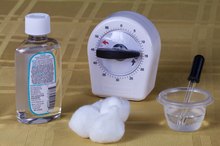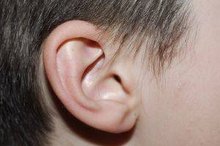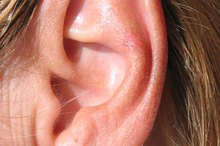How to Remove Impacted Ear Wax
People with impacted ears complain of dizziness, feeling that their ears are "full," hearing loss and irritability. Remember that while impacted ears need medical attention, some earwax is normal.
If you are experiencing serious medical symptoms, seek emergency treatment immediately.
Special sweat glands in your outer ear canal produce wax to keep the canal lubricated and clean.
As the wax forms, it moves slowly toward the opening of your ear. Wax helps to keep water out and traps foreign particles such as dirt and dust. If you know what you are doing and have the right instruments, you can get rid of the wax impaction at home.
Prepare the glycerin, eye dropper and a cotton ball to put drops in your ear. Draw up glycerin into the eye dropper, then tilt your head to the opposite side and put your unaffected ear on your shoulder. This lifts and exposes your impacted ear. With your head tilted, slowly squeeze the eye dropper until you have three to four drops of glycerin in your ear. Put the cotton ball into your ear. Leave the glycerin and cotton ball in until the next day. When you shower, take out the cotton ball and rinse your ear gently, allowing it to drain. Sleep with a towel on your pillow while performing this treatment so your linens stay clean. Repeat this step until the impacted wax softens and dislodges. Quite often, you will need only one application.
The Best Way to Clean Out Your Ears
Learn More
Purchase and use Debrox if the glycerin treatment does not work, or if you want to use a peroxide-based treatment. Debrox is an over-the-counter ear wax removal medication. Fill the applicator with Debrox, then tilt your head, exposing the affected ear. Put in the recommended amount of drops and place a cotton ball in your ear. Do this twice daily. In between doses, take out the cotton ball and flush your ear canal. To do this, get the rubber ear syringe (you can purchase this at the pharmacy) and a towel. Stand so that your head is over the bathroom sink and drape the towel over your shoulder and under the affected ear. Fill the syringe with warm water and gently squeeze it into your ear. This process removes the impacted wax. Repeat the entire process as needed over a four-day period.
Use mineral or baby oil in the ear if you don't have access to either glycerin or Debrox. Get the oil, eye dropper and a cotton ball. Draw up oil into the eye dropper. Tilt your head to the opposite side, putting your unaffected ear on your shoulder to lift and expose your impacted ear. Slowly squeeze the eye dropper with your head tilted until you have three to four drops of oil in your ear. Put the cotton ball into your ear, then leave the oil and cotton ball in until the next day. When you shower, take out the cotton ball and rinse your ear gently, allowing it to drain. Sleep with a towel on your pillow while performing this treatment. Repeat this step until the impacted wax softens and dislodges. Many times with this method, only one application will be needed.
How to Use an Ear Wax Cleaning Kit
Learn More
See your doctor if you have tried to remove the earwax on your own but were unsuccessful. She can easily remove any impacted wax in her office with special instruments. She also can see deep into your ear with an otoscope, ensuring that the wax is completely removed. If there is any damage or infection, she will prescribe antibiotics or pain medication until your ear has fully healed.
Tips
If you experience ear pain that is severe or note drainage coming from your ear canal, see a physician. You may have an infection that requires antibiotics.
Warnings
Using devices to pick out your ears is dangerous. Any time you put an object inside your ear canal, you risk rupturing the ear drum.
Avoid using cotton swabs in your ears. In most cases of impaction, a cotton swab has been used. Cotton swabs do not remove wax; instead, they push it farther into the ear canal where it does not belong. Wax will continue to build, deep within the ear, until impaction occurs.
Related Articles
Tips
- If you experience ear pain that is severe or note drainage coming from your ear canal, see a physician. You may have an infection that requires antibiotics.
Warnings
- Using devices to pick out your ears is dangerous. Any time you put an object inside your ear canal, you risk rupturing the ear drum.
- Avoid using cotton swabs in your ears. In most cases of impaction, a cotton swab has been used. Cotton swabs do not remove wax; instead, they push it farther into the ear canal where it does not belong. Wax will continue to build, deep within the ear, until impaction occurs.
Writer Bio
Ashlee Simmons has written professionally for more than 10 years. Her writing focus is travel, equestrian and health and medical articles, but she enjoys writing human interest stories as well. Simmons graduated from The University of Texas at Austin with a liberal arts degree.









